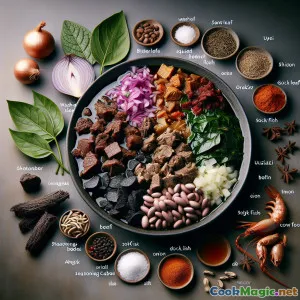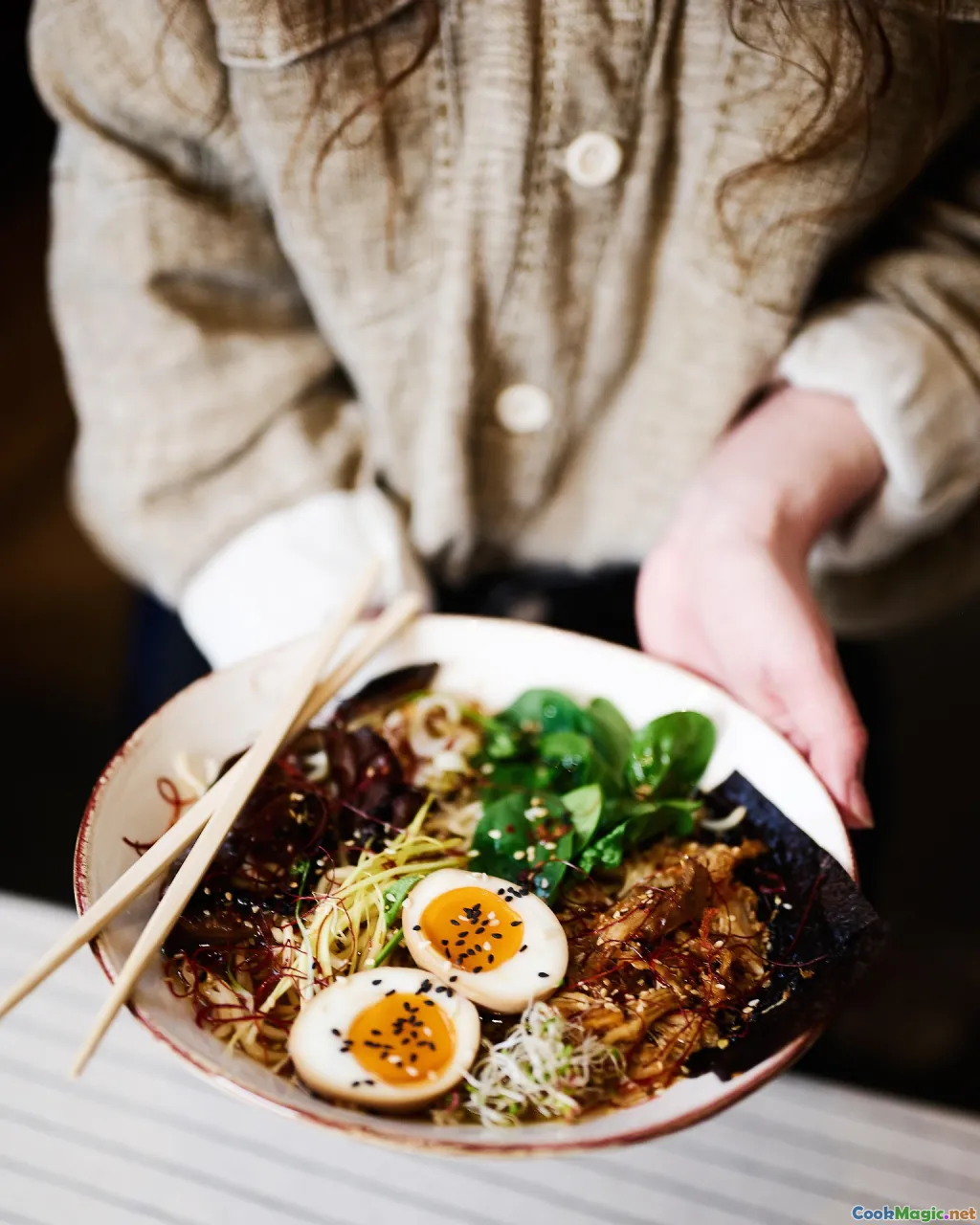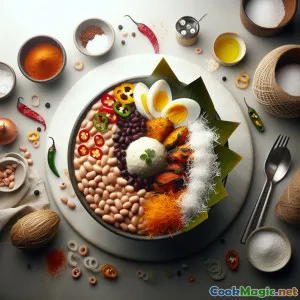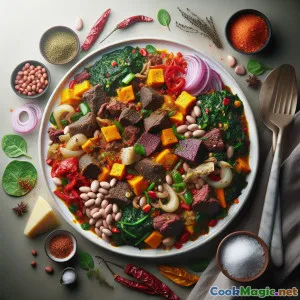
Edo Black Soup: Hearty Delicacy with Assorted Meats
(0 Reviews)Ingredients
-
2 cups Bitterleaf (washed & squeezed)
(Well-washed to remove bitterness)
-
1 cup Scent leaf
(Alternative: basil leaves)
-
1 cup Uziza leaves
(Adds peppery depth)
-
800 grams Assorted meats (goat meat, shaki, beef, cow foot)
(Cut into bite-size pieces)
-
100 grams Stock fish
(Soaked till soft)
-
1 medium Dry Fish
(Deboned and shredded)
-
70 ml Palm oil
(For authentic flavor)
-
2 tbsp crayfish
(Ground)
-
2 tsp Ground pepper
(Adjust to taste)
-
1 medium Onion
(Chopped)
-
1 tbsp Locust beans (iru/ogiri)
(Fermented seasoning, optional)
-
2 pieces Seasoning Cubes
(To enhance umami)
Salt, to taste
-
6 cups Water
(As needed)
(Well-washed to remove bitterness)
(Alternative: basil leaves)
(Adds peppery depth)
(Cut into bite-size pieces)
(Soaked till soft)
(Deboned and shredded)
(For authentic flavor)
(Ground)
(Adjust to taste)
(Chopped)
(Fermented seasoning, optional)
(To enhance umami)
(As needed)
Nutrition
- Servings: 4
- Serving Size: 1 deep bowl (350g)
- Calories: 420 kcal
- Carbohydrates: 14 g
- Protein: 40 g
- Fat: 23 g
- Fiber: 5 g
- Sugar: 3 g
- Sodium: 850 mg
- Cholesterol: 110 mg
- Calcium: 120 mg
- Iron: 4 mg
Instructions
-
1 - Prepare Leaf Puree:
Rinse bitterleaf, scent leaf, and uziza leaves. Blend together with minimal water till smooth. Set aside.
-
2 - Boil Meats:
Rinse and combine assorted meats, stock fish, dry fish, and chopped onion in a large pot. Add enough water to cover, season with salt and seasoning cubes. Boil till meats are tender and liquid reduces.
-
3 - Start Soup Base:
Add palm oil into the pot with meats and broth. Stir well to combine and allow to simmer on medium heat.
-
4 - Add Aromatics & Season:
Mix in crayfish, ground pepper, and locust beans (if using). Stir and simmer for 3 minutes.
-
5 - Add Leaf Puree:
Gently add the blended leaf mixture into the soup. Stir thoroughly to blend the color and flavors. Add water to adjust consistency, as needed.
-
6 - Final Simmer & Serve:
Taste and adjust seasoning. Simmer gently for another 10 minutes until the soup thickens and a deep black-green color is achieved. Serve hot with pounded yam, eba, or fufu.
Rinse bitterleaf, scent leaf, and uziza leaves. Blend together with minimal water till smooth. Set aside.
Rinse and combine assorted meats, stock fish, dry fish, and chopped onion in a large pot. Add enough water to cover, season with salt and seasoning cubes. Boil till meats are tender and liquid reduces.
Add palm oil into the pot with meats and broth. Stir well to combine and allow to simmer on medium heat.
Mix in crayfish, ground pepper, and locust beans (if using). Stir and simmer for 3 minutes.
Gently add the blended leaf mixture into the soup. Stir thoroughly to blend the color and flavors. Add water to adjust consistency, as needed.
Taste and adjust seasoning. Simmer gently for another 10 minutes until the soup thickens and a deep black-green color is achieved. Serve hot with pounded yam, eba, or fufu.
More About: Edo Black Soup: Hearty Delicacy with Assorted Meats
Edo Black Soup with Assorted Meats: The Taste of Nigerian Heritage
Introduction
Edo Black Soup is a storied delicacy originating from the Edo State of Nigeria, revered for its deep herbal notes, nutritional punch, and the dramatic black-green color that comes from blending specific local leaves. This striking dish stands out not just visually, but also for its layers of earthy flavor and the tender assortment of meats traditionally steeped in its rich elixir. Often savored with classic Nigerian swallows like pounded yam or fufu, it’s a dish that truly encapsulates the culinary and cultural pride of southern Nigeria’s Edo-speaking people.
The Heart of the Dish: What Makes Edo Black Soup Unique
Unlike many other prominent West African soups which might lean greatly on tomatoes or reddish palm oil bases (like egusi or ogbono), Edo black soup is gracefully dominated by a blend of local greens. The combination of bitterleaf, scent leaf (nchuanwu), and sometimes uziza yields a puree that colors and flavors the soup in entirely unique ways.
The process of meticulously washing the bitterleaf is crucial: back home, this can take a whole afternoon, with multiple rinses to remove its trademark bitterness while preserving enough earthiness to distinguish the soup from the leafy vegetable. Each cook’s hand determines just how much bitterness remains—a testimony to inherited techniques and personal taste. Scent leaves—fragrant, anise-like and peppery—add an aromatic complexity, while optional uziza impost as a rooty, slightly spicy undertone.
Meats play a critical role in the heartiness of this dish; every morsel of beef, shaki (tripe), and ‘assorted’ protein softens and absorbs the nebulous herbal foundation. The addition of stockfish or dry fish, often a sign of celebration or gathering, gives that coveted 5th taste—umami—further amplified by ground crayfish and fermented locust beans, traditional Nigerian seasonings known to pack flavor in small amounts.
Personal Thoughts and Tips
If you’re sourcing fresh Nigerian leaves outside the country, substitutions such as kale, spinach (for scent leaf), or a thoughtful blend of mixed greens can somewhat mimic the original texture but may not fully replicate the boldness unique to Nigerian foliage. Taking time with washing the bitterleaf and blending to a smooth consistency is non-negotiable for authenticity and mouthfeel. Advanced cooks in Nigeria often use multiple fresh and dried fishes simultaneously for even deeper flavor intricacies.
Getting the consistency right is another subtlety—Edo black soup should pour but retain a thick texture, enough to cling to accompanying starches without running. Be judicious with palm oil; its subtle smokiness and depth matter, but the deep greenish-black of the leaves should always shine.
History and Cultural Importance
The Edo black soup likely traces its roots centuries back to times when food wasn’t just sustenance, but medicine and sacred ritual. Herbal soups and their bitters provided vitamins, detoxification after periods of intensive farm work, and even condolence or celebration in family rites. In many Edo homes, recipes for black soup are regarded with familial pride, often shared through oral tradition—from mothers and grandmothers who teach careful blending, tasting, and serving etiquette.
Local celebrations, chieftaincy installations, weddings and festivals often feature large communal pots of black soup, serving as an edible emblem of Edo State’s culinary gifts. It is a dish for restorative family meals, healing, gathering, and remembrance—a beautiful, edible reflection of heritage.
Final Tips for Success
For the uninitiated, sourcing Nigerian or African groceries online or in specialties markets will yield the best ingredients. Blending the leaves freshly matters for optimal flavor and the iconic black shade. Resist overcooking the leaf mixture—instead, maintain a gentle simmer, always stirring to prevent sticking on the bottom of the pan.
Be bold with protein: goat meat brings gamey depth, but combining it with tender shaki, stockfish, and brisket results in singular taste richness—a celebration worthy. To finish, serve hot with pounded yam, eba, amala, or your preferred swallow. No sincere Nigerian household would pass up the experience of savoring black soup: it’s vibrantly healthy, mouthwateringly savory, texturally pleasing, and—above all—rich in the unspoken stories of Edo land.
























